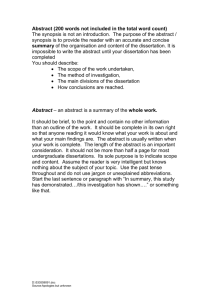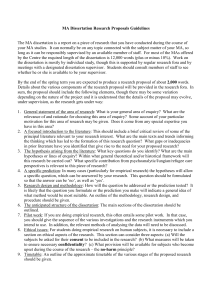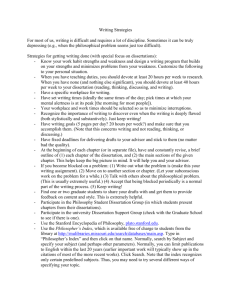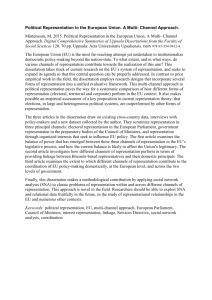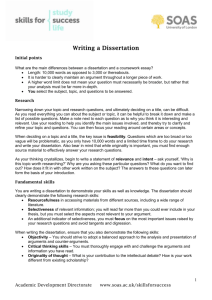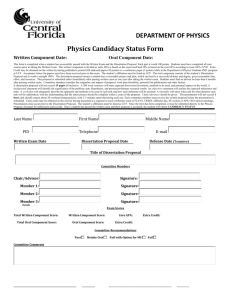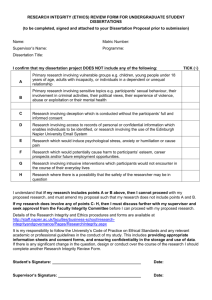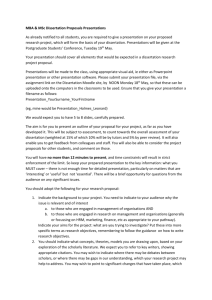PDF Traditional Template
advertisement
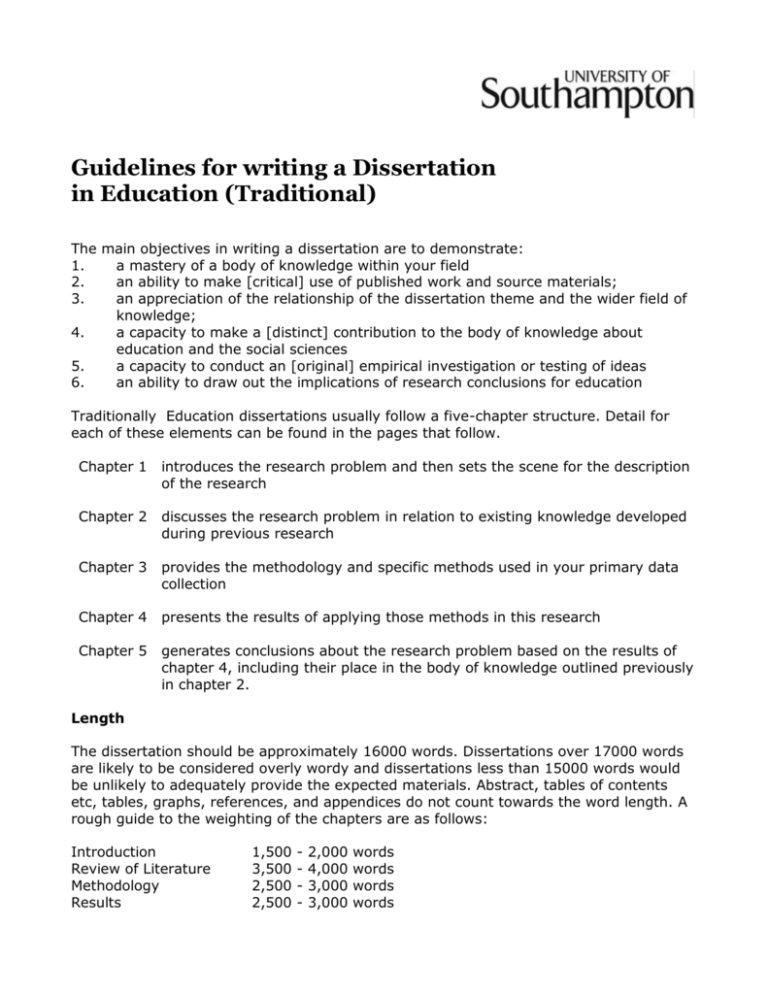
Guidelines for writing a Dissertation in Education (Traditional) The main objectives in writing a dissertation are to demonstrate: 1. a mastery of a body of knowledge within your field 2. an ability to make [critical] use of published work and source materials; 3. an appreciation of the relationship of the dissertation theme and the wider field of knowledge; 4. a capacity to make a [distinct] contribution to the body of knowledge about education and the social sciences 5. a capacity to conduct an [original] empirical investigation or testing of ideas 6. an ability to draw out the implications of research conclusions for education Traditionally Education dissertations usually follow a five-chapter structure. Detail for each of these elements can be found in the pages that follow. Chapter 1 introduces the research problem and then sets the scene for the description of the research Chapter 2 discusses the research problem in relation to existing knowledge developed during previous research Chapter 3 provides the methodology and specific methods used in your primary data collection Chapter 4 presents the results of applying those methods in this research Chapter 5 generates conclusions about the research problem based on the results of chapter 4, including their place in the body of knowledge outlined previously in chapter 2. Length The dissertation should be approximately 16000 words. Dissertations over 17000 words are likely to be considered overly wordy and dissertations less than 15000 words would be unlikely to adequately provide the expected materials. Abstract, tables of contents etc, tables, graphs, references, and appendices do not count towards the word length. A rough guide to the weighting of the chapters are as follows: Introduction Review of Literature Methodology Results 1,500 3,500 2,500 2,500 - 2,000 4,000 3,000 3,000 words words words words Discussion 3,500 - 4,000 words For further detail read Creswell, J. (1994/2003). Research Design: Qualitative and Quantitative Approaches. Thousand Oaks: Sage. Chapter 1: Introduction The purpose of the introduction chapter is to provide readers with the background information for the research reported in the subsequent chapters. Generally introductions in the social science follow the ‘deficiencies model’, which involves presenting the research problem, providing a brief overview of the literature concerning the problem and outlining their deficiencies, then explaining the importance of undertaken the research and finally a specific statement of the research problem and questions. A typical structure would be: Introduction Background to the Research Research Problem followed by the aim or objectives / purpose statement and research questions Justification of the Research - relevance and significance of the study, - who will benefit; - who will use your conclusions; policy makers/ practitioners/ researchers - why they will use it Summary Chapter 2: The Literature Review The second chapter serves several purposes. It shares with the reader the results of other studies that are closely related to the study being reported. It also relates a study to the larger ongoing dialogue in the literature about a topic. It provides a framework for establishing the importance and relevance of the study as well as setting a benchmark for comparing your results with other studies (see Creswell, 2003) A typical Chapter 2 would use a funnelling approach. First, the wider theory is presented and discussed. Next, empirical research that has addressed your topics is reviewed. Then specific research that has examined your topic in the same context is presented. For example, a study examining motivation of employees in sporting organisations would begin by presenting the current theories and thinking about workplace motivation. Then it would examine current empirical research on the topic and thirdly it would look at other studies that have examined motivation or similar concepts in sporting organisations. It is worth noting that literature concerning your topic is used in three places in the dissertation. Chapter 1 uses literature to ‘frame’ the problem; Chapter 2 presents the ‘review of the literature’; and Chapter 5 uses the literature mentioned in Chapters 1 and 2 as a basis for comparing and contrasting the findings of the study. Chapter 3: Methodology Chapter 3 describes the philosophy of the research design and the procedures used to undertake your research. It is written so that the procedures are explicit and thereby another researcher should be able to replicate the research. The chapter comprises of two parts. Firstly, the research philosophy (the theoretical underpinning of the methods) is clearly explained. There should be a clear statement of the issues for investigation and a rationale for the choice of methods by which these are to be investigated. Secondly, the chapter explains the methods and techniques that were used. The chapter should cover such things as: setting and participants; procedures used to collect data, and the major ways the data was analysed. Thus, this chapter describes the methods adopted in far more detail than the initial description in the first chapter A typical structure would be: Introduction Research philosophy and design Description/justification of participants and the method(s) of selection Description/justification of data collection methods Description/ justification of collection instrumentation Outline of the proposed data analysis methods Limitations of your methods (may be presented here or in Chapter 5) Ethics and Risk Management procedures Summary Chapter 4: Results The chapter should be clearly organised using appropriate headings that are usually associated with the research questions preferably in the same order as the questions. The chapter must contain explanatory text that introduces the chapter (link it with the previous chapter), paragraphs that introduce each section by linking them to research questions, text that presents main findings with clarity and impact, and explains detail closely associated with these findings. That is, the chapter will be largely text in appropriate headed sections. However, to add variety as well as simplicity, this chapter often makes use of other forms of presentation of information such as tables and charts. A typical structure would be: Introduction Describe the participants Describe the overall responses to the major concepts/variables Report differences between sub-groups Report relationships between major concepts/variables Summary Alternatively Introduction Describe the participants Describe the overall responses to the major concepts/variables Address each of your research questions in turn Other interesting findings Summary Chapter 5: The Discussion Although Chapter 5 is arguably the most important chapter of the dissertation because it describes the conclusions of the research and their implications, it is sometimes marred by lack of impact and insightfulness. So dissertation writers must make a special effort to ensure that this chapter is worthy of the rest of the dissertation. The main functions of this chapter are to declare the answers to the research questions and to show and justify the contribution of these conclusions to the body of knowledge in the relevant field. A typical structure would be: Introduction Discussion of Results in relation to other literature and past studies Recommendations Limitations Implications for Theory Implications for Policy / Practice Further Research Concluding Statement
